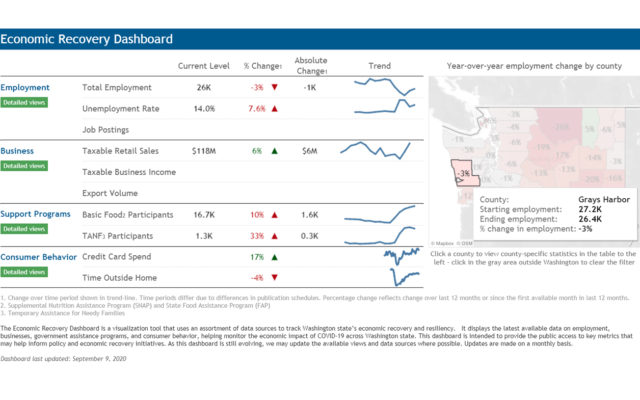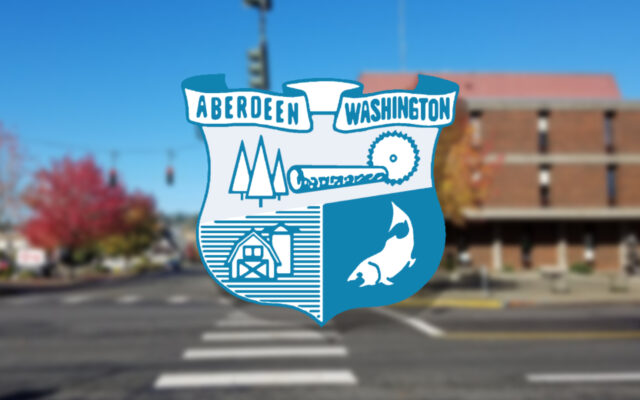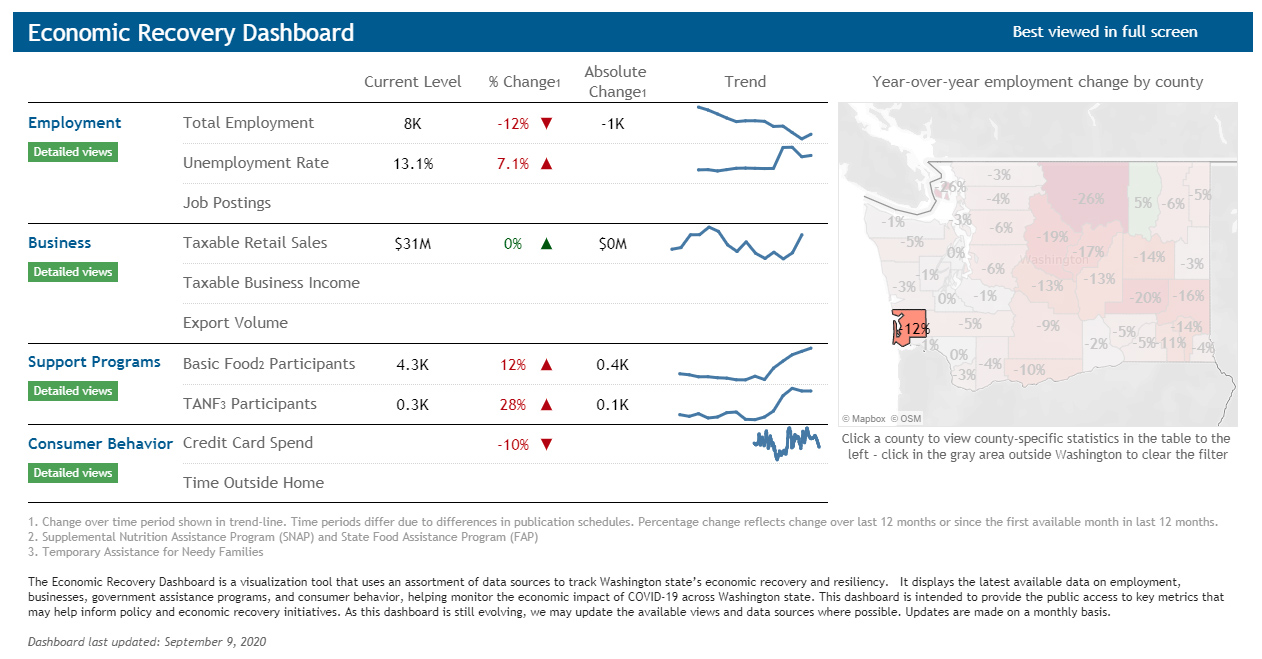New dashboard shows the economic impact this year has had locally

The Washington State Department of Commerce has launched a new online dashboard that uses a variety of sources to track Washington state’s economic recovery and resiliency.
The state department says that the new Economic Recovery Dashboard displays the latest available data on employment, businesses, government assistance programs and consumer behavior, helping monitor the economic impact of COVID-19 across our state.
“The economic impact of COVID-19 on individuals, families and businesses is like nothing we’ve ever seen before,” said Washington State Commerce Director Lisa Brown. “The depth and complexity of the challenge we’re dealing with demands that we use data in new ways to help every family, every community and every industry get back on their feet, stronger and more resilient than before.”
Brown and Chris Green, Assistant Director of Economic Development and Competitiveness at Commerce, unveiled the state’s new tool for analyzing and visualizing data from public and private organizations to reliably examine the impact of COVID-19 on the state’s economy.
“The dashboard details, on regional, demographic and industry sector levels, numerous metrics that could help guide state and local leaders as they chart a path to an equitable, statewide economic recovery.”
Locally, it shows that year-over-year, Grays Harbor has seen a 3% loss to Total Employment and a 7.6% gain in the Unemployment Rate. Along with those changes, the total number of Basic Food or TANF participants increased since 2019, 19% and 33% respectively.
Despite these changes, the local Taxable Sales have increased by 6%, or $6 million and the Credit Card Spend increased 17%.
In Pacific County, they saw no positive changes year-over-year. The county had a 12% drop in Total Employment and a 7.1% increase to the Unemployment Rate.
Taxable Retail sales remained steady, with no increase or decrease, but the Credit Card Spend dropped by 10%.
Along with these changes, there was a 12% increase in Basic Food participants and a 28% increase in TANF residents.
Statewide, the dashboard shows that there were negative impacts in all areas.
The dashboard is available to the public on the Commerce website. Brown says local, regional and state leaders can more effectively focus economic recovery efforts by tracking the varying impact of the pandemic and needs through a prolonged slowdown.
“The length and depth of the pandemic has resulted in a global slow down that has affected businesses, communities and geographic regions of our state in unique ways,” Brown said. “A northeastern timber community grappling with loss of a major mill employer. Central Washington agricultural communities facing huge declines in exports. Small service business in urban Puget Sound coping with massive customer losses as office workers stay home and the aerospace industry struggles. We can’t have an equitable recovery without in-depth data. Approaches to recovery must be as diverse as our economy itself.”
The Economic Recovery Dashboard uses select data from a variety of reliable sources to display the latest available status of employment, businesses, government assistance programs and consumer behavior. It provides insight into the current impact of COVID-19, and over time, will help identify which communities or industries are recovering and which need continued support.
“The Economic Recovery Dashboard developed by our partners at Commerce complements well with our Washington in the Making portal that is measuring the state’s business environment and other key factors such as infrastructure connectivity, talent, entrepreneurship and innovation,” said Kris Johnson, Association of Washington Business (AWB) President. “Working together, we now have an incredibly robust set of tools for building a thriving, resilient and connected economy that includes every community in our state.”
“Washington state’s diversity is a tremendous strength, but it also means that our unique regional economies are experiencing the impact of the pandemic very differently,” said Suzanne Dale Estey, Washington Economic Development Association (WEDA) Executive Director. “Detailed data provided by this new dashboard will help economic development and community leaders identify and tailor appropriate supports to assist equitable recovery throughout the state.”
Commerce says that the data indicates that expanding broadband access and affordability is an economic imperative, particularly for rural and historically disadvantaged communities. High-speed internet is now essential for students to attend classes, for seniors to access their doctors and prescriptions, for workers to connect with employers and job opportunities, and businesses to keep their doors open.
Data from the dashboard, taken together with the Washington Broadband Office mapping initiative, could help guide effective policies and prioritize investments in broadband infrastructure.
Brown and Assistant Director Chris Green provided a demonstration of the new dashboard. You can view it on TVW.
Current Economic Recovery Dashboard highlights
- Two months after reopening efforts began, Washington’s employment decline is still 30% greater than the lowest point in the Great Recession a decade ago.
- Unemployment trends in Washington state are tracking similarly with most other states with a steep drop through April and slow but steady growth since May.
- While construction has recovered 80% of lost jobs as of June, leisure and hospitality has only recovered about one-third of job losses and is the hardest hit of all industries.
- There are early signs of disproportionate unemployment impacts across race groups, particularly Pacific Islanders and Black workers.
- An additional 100,000 people have signed up for food or temporary cash assistance since February, with larger increases in central Washington, Spokane and Tri-Cities areas.
The Economic Recovery dashboard was developed with federal CARES Act funding to provide actionable data analysis and improve understanding of where and how the COVID-19 pandemic is impacting Washington state. The dashboard will evolve as Commerce updates the available views and data sources where possible. Data is currently updated on a monthly basis. Commerce cannot provide raw data, but sources are cited to provide more information where available.
Updates are made monthly. Work is ongoing to improve the user experience of this tool.
You Might Also Like





